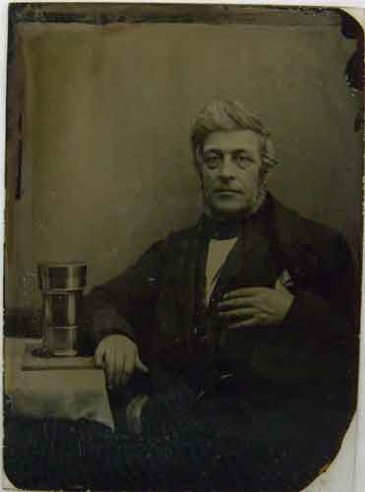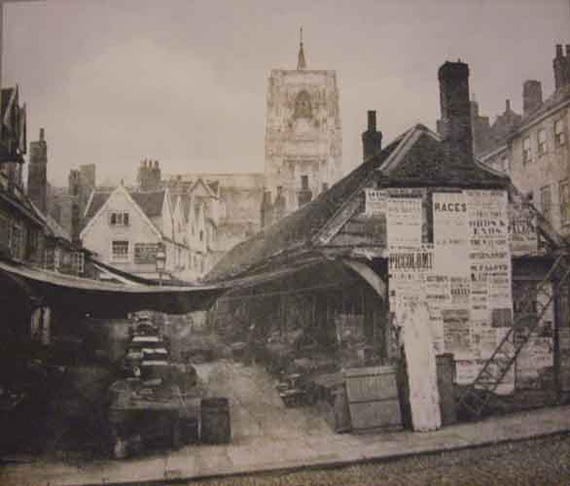1840 - 1860
Brewer, insurance agent, artist and photographer
Thomas Lound lived and worked in (Lower) King Street, Norwich as a confidential clerk [manager] in the brewery trade for 35 years at Charles Tompson & Sons. He was also an agent for the County Fire and Provident Life Offices and he regularly advertised his services in local newspapers.
As an amateur artist his main medium was water-colour. Traditionally, he was believed to have been taught by John Sell Cotman and became a talented landscape painter. Occasionally he painted in oils and between 1832 and 1834 he made etchings1, now very rare, of river views. He chose riverside scenes and architectural detail and exhibited extensively in Norwich and showed 19 pictures at the Royal Academy. He was actively involved in the establishment of the Norwich School of Design which was formally opened in 1846.
He was a member of the Norwich School of Artists and his friends included the artists Henry Bright, Thomas Leman and John Middleton. A keen amateur photographer and, as a committee member of the Norwich Photographic Society, he showed five of his own photographs in its 1856 exhibition. They were all printed from wax paper negatives; two of Ely Cathedral, two of Bromholm(e) Priory and one of the Fish Market, Norwich. The original print of the Fish Market shows a poster advertisement for a concert by Madlle. Piccolomini on the 23rd September 1856. The exhibition catalogue doesn’t detail the size of his prints but, given the glass plate sizes stated in his posthumous sale catalogue, it is likely that sometime in the 1850s he made some large format prints, perhaps as large as 16 x 12 inches, from collodion glass-plate negatives. In one of the images below Lound is shown seated alongside his Ross 4 inch lens. Taken by an unidentified photographer [possibly a self-portrait], it is a collodion positive, [aka an ambrotype] essentially a black-backed glass negative which shows correct tonal values when viewed in reflected light.
Following Lound’s death in 1861, Messrs. Spelman2 sold his effects by auction in the Exhibition Room at the Bazaar, St. Andrews, Norwich. In addition to pictures and drawings, the sale included a camera lucida, photographs and photographic equipment. In the introduction to the catalogue we read:
‘MR. LOUND’S attractive social qualities procured him a widely extended circle of friends; whilst his indefatigable and eminently successful application to art – in which a correct knowledge of chiaro-oscura, and perfect truthfulness to nature in colour, united with innate genius, were especially remarkable – earned for him a celebrity that many professional men might have good reason to envy.’
Sources and Notes
- Pidgley, Michael. Thomas Lound 1802-1861, A Set of New Impressions. Pamphlet, n.d. Private publication
- Messrs. Spelman, Clement Charles Rix Spelman,Norwich auctioneer.
The catalogue listing for Lound’s effects shows:
The photographs offered in the sale of his effects were:Pair, very fine, Welch [sic] scenery R. Harmer [see Photographers] Pair, fine .. .. R. Harmer ditto .. R. Harmer Four ditto .. R. Harmer Ten, various, with 4 views of Ketteringham Hall [Residence of Sir John Boileau] Pair of calotypes, Taylor, and 2 others, and folio. [ Taylor probably Thomas Lombe Taylor of Starston, Norfolk]
The photographic equipment included:
Folding camera, with double slide for paper and 2 single slides for glass, in leather case with stand
Large folding camera, with slides, stand, and a 4-inch Rosse’s [sic] lens, in leather case
A tent with stand
Large case, with contents of plate glass:
six 12 by 16 in.; twelve 10 by 14; and six 8 x 12
A box with eight 10 by 12 in. plates
About 14 plates various sizes
Fourteen large plates of glass
Folio and cards for wax negatives
Folio and contents of waxed paper for negatives
Four pressure frames
and various dishes, funnels, holders, bottles of chemicals and sundries.
An excellent reference about the Norwich School of Art is:>
Allthorpe-Guyton, Marjorie with Stevens, John. A Happy Eye. A School of Art in Norwich 1845-1982. Norwich, Jarrold and Sons, Ltd., 1982.

Photographer unidentified
Portrait of Thomas Lound
Collodion positive, 1850s
[Norwich Castle Museum]

Norwich Fish Market
Salted paper print, 1856
[Norfolk County Council Library and Information Service]